Möchten Sie Facebook-Kommentare in WordPress installieren und einrichten?
Facebook ist das größte soziale Netzwerk der Welt. Deshalb verwenden viele WordPress-Blogs Facebook-Kommentare auf ihren Websites, um die Sichtbarkeit auf Social-Media-Plattformen zu erhöhen und ein größeres Publikum zu erreichen.
In diesem Artikel zeigen wir Ihnen, wie Sie Facebook-Kommentare in WordPress Schritt für Schritt installieren und einrichten können.
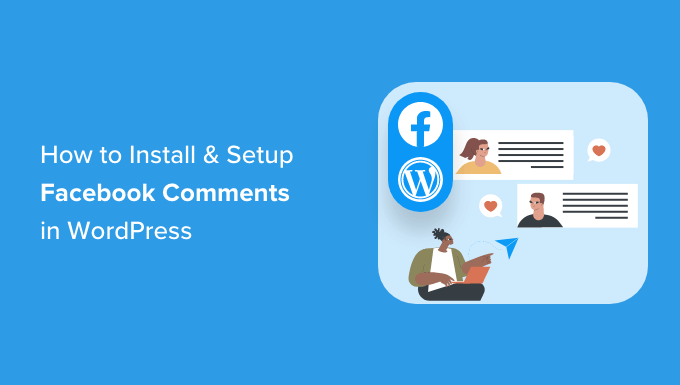
Vor- und Nachteile der Verwendung von Facebook-Kommentaren in WordPress
Bevor wir mit dem Tutorial beginnen, wollen wir die Vor- und Nachteile von Facebook-Kommentaren im Vergleich zu den Standard-WordPress-Kommentaren erläutern.
Einer der offensichtlichsten Vorteile der Verwendung von Facebook-Kommentaren ist, dass sie die Sichtbarkeit Ihrer Website auf Facebook erhöhen können.
Wenn jemand einen Kommentar auf Ihrer WordPress-Website hinterlässt, kann er die Option „Auch auf Facebook posten“ aktivieren, um seinen Kommentar mit seinen Facebook-Freunden zu teilen. Dies birgt ein großes Potenzial für zusätzlichen Traffic auf Ihrer Website.
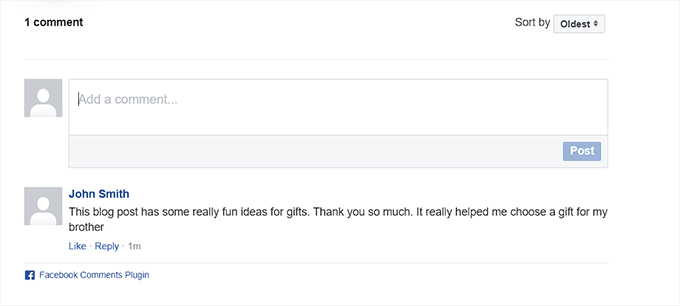
Ein weiterer Vorteil der Verwendung von Facebook-Kommentaren ist die Aufhebung der Anonymität. So ist es weniger wahrscheinlich, dass Nutzer Spam-Kommentare hinterlassen, weil sie mit ihren Facebook-Profilen verbunden sind.
Dies kann jedoch auch ein großer Nachteil sein.
Einige Nutzer fühlen sich vielleicht nicht wohl dabei, einen Kommentar über ihr Facebook-Profil zu hinterlassen, weil sie gerne anonym bleiben.
Ein weiterer Nachteil der Verwendung von Facebook-Kommentaren ist, dass sie nicht in WordPress gespeichert oder synchronisiert werden. Im Gegensatz dazu werden Kommentarsysteme von Drittanbietern wie Disqus mit WordPress synchronisiert.
Wenn Sie außerdem ältere Beiträge mit Standard-WordPress-Kommentaren haben, können diese Kommentare vor oder nach den Facebook-Kommentaren erscheinen.
Aus diesem Grund empfehlen wir, das WordPress-Kommentarsystem vollständig zu entfernen, wenn Sie das Facebook-Kommentarsystem in Ihrem WordPress-Blog verwenden möchten. Andernfalls können Spammer und Bots WordPress-Kommentare nutzen, um Ihre Website zu spammen.
Da Sie nun die Vor- und Nachteile kennen, lassen Sie uns einen Blick darauf werfen, wie Sie Facebook-Kommentare in WordPress installieren und einrichten:
Methode 1: Einrichten von Facebook-Kommentaren in WordPress mit einem kostenlosen Plugin
Sie können sich dieses Video ansehen, um die erste Methode zu verstehen. Wenn Sie jedoch schriftliche Anleitungen bevorzugen, dann können Sie nach unten scrollen.
Zunächst müssen Sie das Lazy Social Comments-Plugin installieren und aktivieren. Weitere Anweisungen finden Sie in unserem Leitfaden für Anfänger zur Installation eines WordPress-Plugins.
Rufen Sie nach der Aktivierung die Seite Einstellungen “ Faule FB-Kommentare in der Seitenleiste des WordPress-Administrators auf.
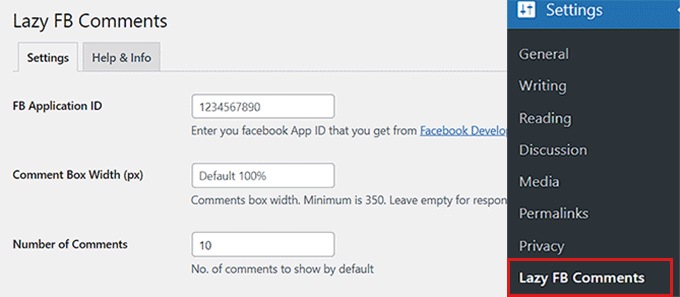
Um Facebook-Kommentare auf Ihrer Website zu verwenden, müssen Sie eine Facebook-App erstellen und dann die Anwendungs-ID auf der Einstellungsseite des Plugins hinzufügen.
Wenn Sie bereits eine Facebook-App haben, können Sie deren ID verwenden.
Wenn Sie jedoch noch keine App erstellt haben, müssen Sie zunächst die Seite Meta for Developers besuchen und ein Entwicklerkonto anlegen.
Hinweis: Bevor Sie ein Entwicklerkonto erstellen, vergessen Sie nicht, sich bei Ihrem Facebook-Konto anzumelden.
Sobald Sie sich als Meta-Entwickler registriert haben, klicken Sie einfach auf den Link „Meine Apps“ in der oberen rechten Ecke des Bildschirms.
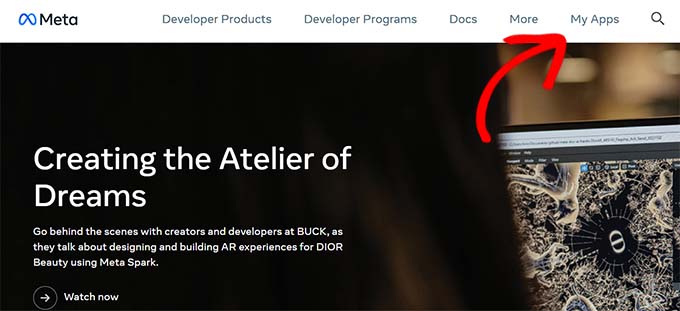
Dies führt Sie zum Dashboard für Entwickler.
Von hier aus klicken Sie einfach auf die Schaltfläche „App erstellen“, um den Vorgang zu starten.
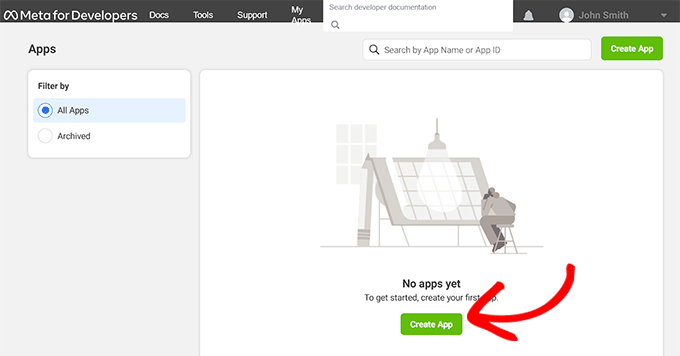
Dies führt Sie zur Seite „App-Erstellung“, wo Sie die Option „Business“ als App-Typ auswählen sollten.
Klicken Sie dann auf die Schaltfläche „Weiter“ am unteren Rand, um fortzufahren.
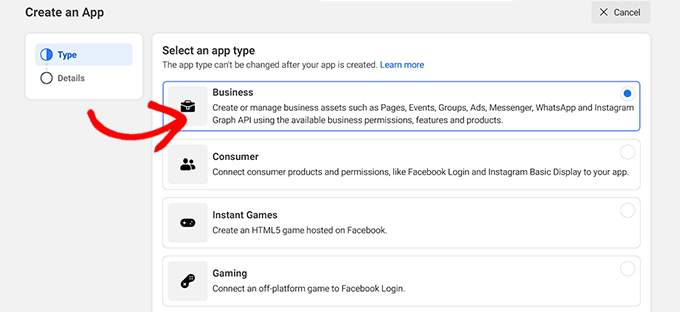
Danach müssen Sie einen App-Namen und eine E-Mail-Adresse angeben, über die wir Sie kontaktieren können.
Stellen Sie sicher, dass Sie eine geschäftliche E-Mail-Adresse verwenden, die Sie regelmäßig überprüfen, damit Sie Aktualisierungen über Ihre Facebook-App erhalten können.
Nachdem Sie die Details eingegeben haben, klicken Sie auf die Schaltfläche „App erstellen“.
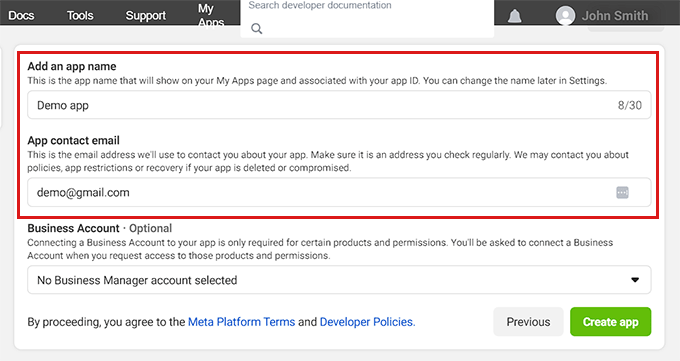
Facebook wird nun eine neue App für Sie erstellen und Sie zum App-Dashboard weiterleiten.
Hier können Sie Ihre APP-ID in der oberen linken Ecke des Bildschirms sehen.
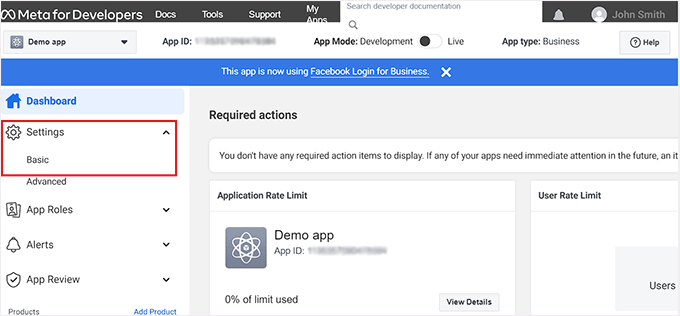
Nun müssen Sie Facebook mitteilen, wie Sie die App verwenden möchten. Gehen Sie dazu in der linken Spalte auf den Link Einstellungen “ Basis.
Klicken Sie anschließend auf die Schaltfläche „+ Plattform hinzufügen“ am unteren Rand der Seite.
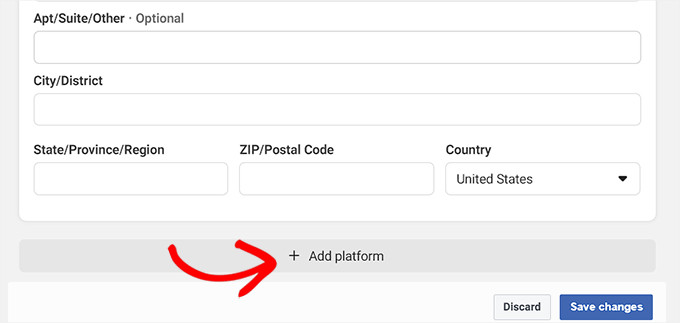
Daraufhin öffnet sich ein neues Popup-Fenster.
Hier müssen Sie die Option „Website“ als Plattform wählen und dann auf die Schaltfläche „Weiter“ klicken, um fortzufahren.
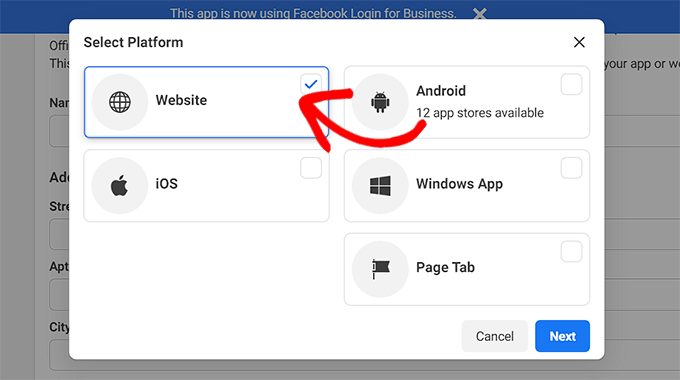
Dadurch wird der Einstellungsseite Ihrer App ein neuer Abschnitt „Website“ hinzugefügt.
Kopieren Sie hier einfach die URL Ihrer WordPress-Website und fügen Sie sie ein. Klicken Sie anschließend auf die Schaltfläche „Änderungen speichern“.

Als Nächstes müssen Sie die APP-ID von oben kopieren und dann in das Feld „FB Application ID“ auf der Plugin-Einstellungsseite in Ihrem WordPress-Dashboard einfügen.
Wenn Sie fertig sind, scrollen Sie nach unten und klicken Sie auf die Schaltfläche „Alle Änderungen speichern“, um Ihre Einstellungen zu speichern.
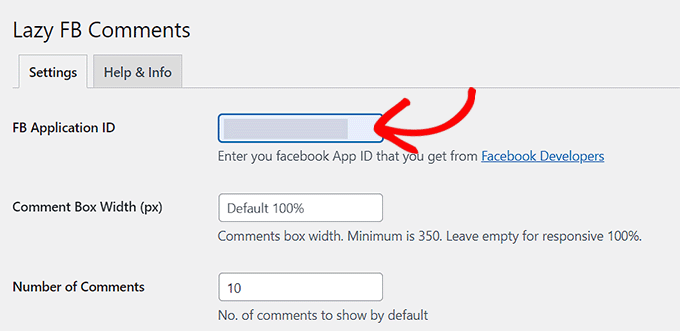
Nun erscheint oben neben dem Namen des Plugins ein neuer Reiter „Kommentare moderieren“. Wie Sie Facebook-Kommentare moderieren können, erklären wir im nächsten Abschnitt.
Auch dieses Plugin verfügt über eine Reihe von Optionen. Sie können durch die Einstellungen gehen, um zu sehen, ob es etwas gibt, das Sie ändern möchten.
Sie können zum Beispiel die Option „Kommentare laden“ in „Beim Blättern“ ändern. Mit dieser Einstellung wird das Facebook-Kommentarsystem nur geladen, wenn jemand das Ende des Artikels erreicht. Dies kann dazu beitragen, die Ladegeschwindigkeit der Seite zu verbessern.
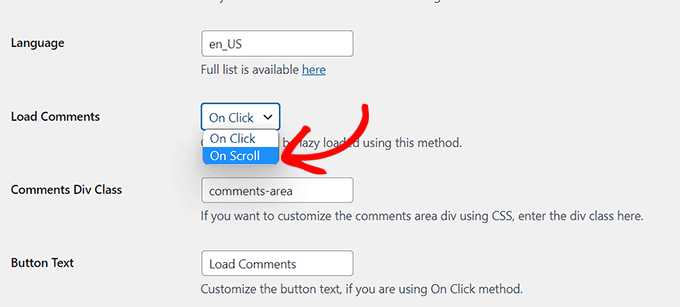
Ansonsten sollten die Standardeinstellungen für die meisten Websites ausreichen.
Jetzt können Sie jeden Beitrag auf Ihrer WordPress-Website besuchen, um das Facebook-Kommentarsystem in Aktion zu sehen.

Facebook-Kommentare auf Ihrer Website moderieren
Als Administrator der Facebook-App erhalten Sie Benachrichtigungen über neue Kommentare, wenn Sie sich bei Ihrem Facebook-Konto anmelden.
Sie finden auch einen Link zum Moderieren von Kommentaren auf der Einstellungsseite des Plugins in Ihrem WordPress-Dashboard.
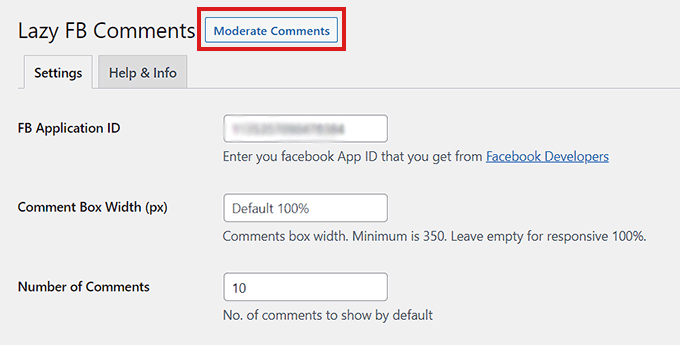
Wenn Sie auf den Link klicken, werden Sie auf die Seite ‚Comment Moderation Tool‘ weitergeleitet.
Klicken Sie hier auf den Link „Einstellungen“, um die Regeln für die Moderation von Kommentaren auf Facebook festzulegen.

Daraufhin öffnet sich ein Popup, in dem Sie auf die Registerkarte „Moderationsregeln“ klicken müssen.
Sie können festlegen, wie viele Zeichen in einem Kommentar maximal erlaubt sind. Sie können auch die Anzahl der Tage festlegen, nach denen die Kommentare zu Ihren Beiträgen automatisch geschlossen werden.
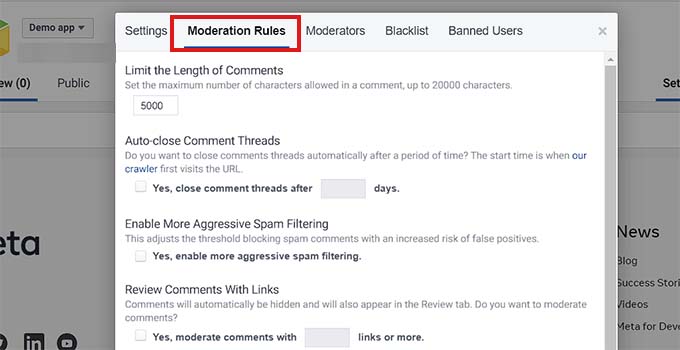
Facebook ermöglicht es Ihnen auch, neue Kommentar-Moderatoren hinzuzufügen.
Klicken Sie einfach auf die Registerkarte „Moderatoren“ und fügen Sie dann eine Person hinzu, indem Sie ihren Namen in das Textfeld eingeben und auf ihr Profil klicken.
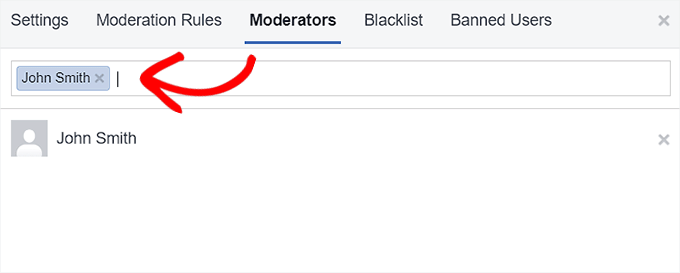
Wenn Sie fertig sind, klicken Sie auf die Schaltfläche „Speichern“, um Ihre Einstellungen zu übernehmen.
Wie man die Anzahl der Facebook-Kommentare in WordPress anzeigt
Einer der Nachteile der Verwendung des Lazy Social Comments-Plugins ist, dass es die WordPress-Kommentarzählfunktion überholt. Auf diese Weise gibt es eine Facebook-Version der Kommentaranzahl aus.
Wenn Ihr Thema die Anzahl der Kommentare anzeigt, würde dies nicht gut aussehen.
Wenn Sie dennoch die Anzahl der Facebook-Kommentare anzeigen möchten, können Sie dies mit Hilfe eines Codeschnipsels tun.
Beachten Sie jedoch, dass der kleinste Fehler bei der Bearbeitung Ihrer Themadateien Ihre Website zerstören kann.
Wir empfehlen die Verwendung von WPCode zum Hinzufügen von Code zu Ihrer Website. Es ist das beste Code-Snippet-Plugin auf dem Markt, mit dem Sie sicher benutzerdefinierten Code hinzufügen können.
Zunächst müssen Sie das WPCode-Plugin installieren und aktivieren. Weitere Einzelheiten finden Sie in unserem Leitfaden für Anfänger zur Installation eines WordPress-Plugins.
Hinweis: Sie können das kostenlose WPCode-Plugin für dieses Lernprogramm verwenden. Um jedoch weitere Funktionen wie eine Cloud-Bibliothek mit Code-Snippets, bedingte Logik und mehr freizuschalten, benötigen Sie den Premium-Plan des Plugins.
Sobald das Plugin aktiviert ist, besuchen Sie die Seite Code Snippets “ + Add Snippet in der Admin-Seitenleiste.
Klicken Sie hier auf die Schaltfläche „Snippet verwenden“ unter der Option „Eigenen Code hinzufügen (neues Snippet)“.

Sobald Sie sich auf der Seite „Benutzerdefiniertes Snippet erstellen“ befinden, geben Sie zunächst einen Namen für Ihr Code-Snippet ein.
Wählen Sie dann aus dem Dropdown-Menü auf der rechten Seite des Bildschirms „HTML Snippet“ als „Code-Typ“ aus.
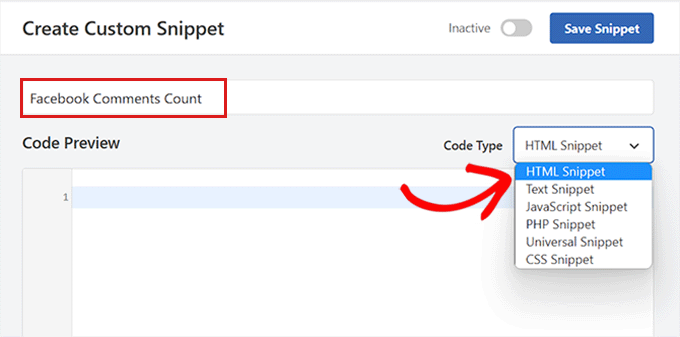
Kopieren Sie anschließend den folgenden Code und fügen Sie ihn in das Feld „Codevorschau“ ein:
<fb:comments-count href="<?php echo get_permalink($post->ID); ?>"></fb:comments-count> Comments
Als Nächstes müssen Sie nach unten zum Abschnitt „Einfügen“ blättern.
Wählen Sie hier als Einfügemethode „Automatisch einfügen“, damit der Code automatisch auf Ihrer Website ausgeführt wird.

Danach müssen Sie einen Speicherort für Ihr Codeschnipsel wählen.
Wählen Sie einfach „Nach dem Inhalt einfügen“ als Speicherort aus dem Dropdown-Menü.
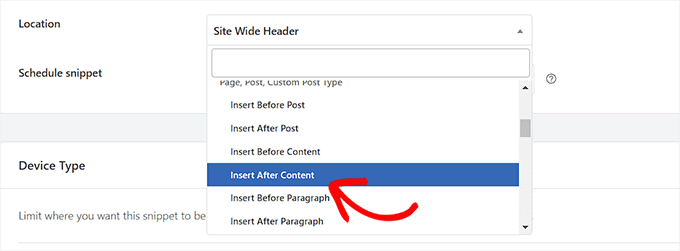
Gehen Sie nun zurück zum Anfang der Seite und schalten Sie den Schalter „Inaktiv“ auf „Aktiv“ um.
Klicken Sie abschließend auf die Schaltfläche „Snippet speichern“, um Ihre Einstellungen zu speichern.
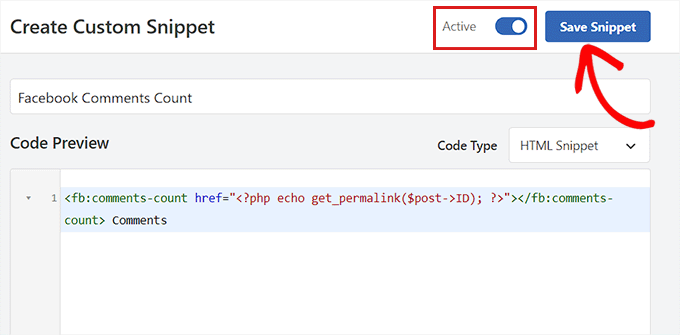
Die Anzahl deiner Facebook-Kommentare wird jetzt bei jedem Beitrag angezeigt.
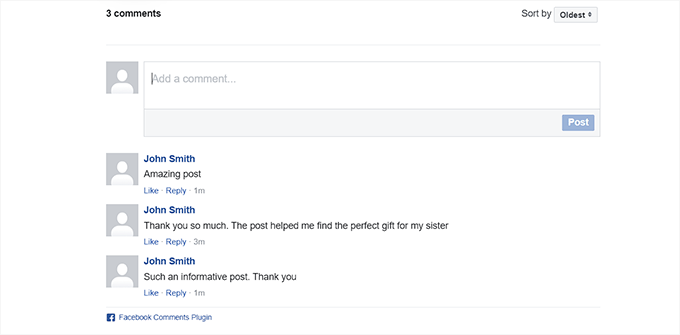
Methode 2: Facebook-Kommentare mit SeedProd einrichten (einfach)
Wenn Sie nach einer einfacheren Möglichkeit suchen, Facebook-Kommentare einzurichten, dann ist diese Methode genau das Richtige für Sie.
Wir werden das SeedProd-Plugin verwenden, das beste WordPress-Seitenerstellungs-Plugin auf dem Markt. Damit können Sie Themes und Landing Pages von Grund auf erstellen, ohne Code zu verwenden.
Zunächst müssen Sie das SeedProd-Plugin installieren und aktivieren. Weitere Anweisungen finden Sie in unserer Schritt-für-Schritt-Anleitung für die Installation eines WordPress-Plugins.
Hinweis: SeedProd bietet auch eine kostenlose Version, die Sie ausprobieren können. Für dieses Tutorial werden wir jedoch die Premium-Version des Plugins verwenden.
Nach der Aktivierung besuchen Sie die Seite SeedProd “ Einstellungen in der Admin-Seitenleiste, um den Lizenzschlüssel einzugeben.
Sie können diese Informationen in Ihrem Konto auf der SeedProd-Website finden.

Als Nächstes gehen Sie in der WordPress-Admin-Seitenleiste zum Abschnitt SeedProd “ Landing Pages und klicken auf die Schaltfläche „Add New Landing Page“.
In diesem Tutorial werden wir Facebook-Kommentare zu einer Landing Page hinzufügen. Wenn Sie möchten, können Sie auch ein ganz neues Thema für Ihre Website mit SeedProd anpassen.
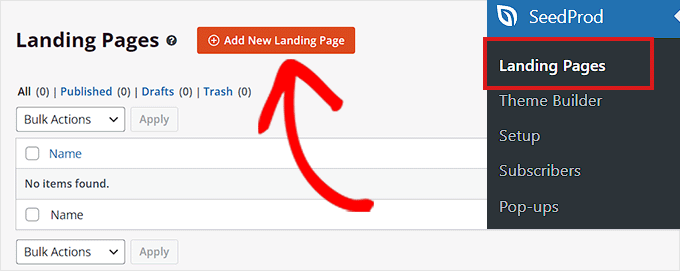
Sie werden nun zum Bildschirm „Neue Vorlage auswählen“ weitergeleitet. Hier können Sie eine der vielen vorgefertigten Vorlagen auswählen, die von SeedProd angeboten werden, oder Ihre eigene Vorlage erstellen.
Danach werden Sie aufgefordert, einen Seitennamen einzugeben und eine URL zu wählen. Klicken Sie anschließend auf die Schaltfläche „Speichern und mit der Bearbeitung der Seite beginnen“, um fortzufahren.
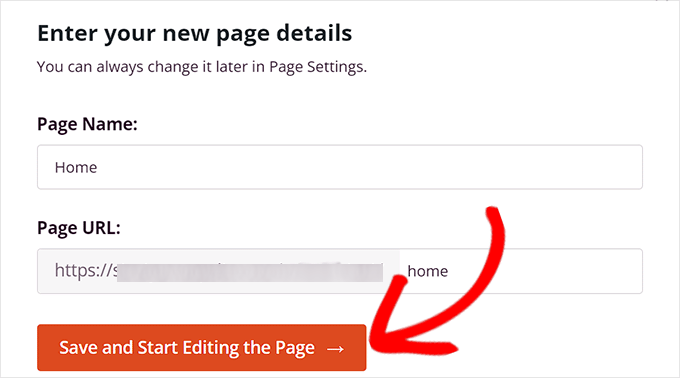
Dadurch wird der SeedProd Drag-and-Drop Page Builder gestartet, mit dem Sie die Seite bearbeiten können. Weitere Details finden Sie in unserem Leitfaden zur Erstellung einer Landing Page in WordPress.
Von hier aus müssen Sie in der Suchleiste nach dem Block „Facebook-Kommentare“ suchen.
Wenn Sie ihn gefunden haben, können Sie den Block „Facebook-Kommentare“ an eine beliebige Stelle auf der Seite ziehen und ablegen.
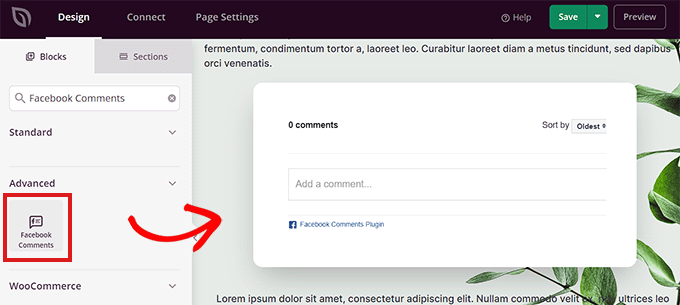
Doppelklicken Sie anschließend auf den Block „Facebook-Kommentare“ auf dem Bildschirm, um die Einstellungen in der linken Spalte zu öffnen.
Von hier aus können Sie die Anzahl der anzuzeigenden Facebook-Kommentare bestimmen, eine Reihenfolge, ein Farbschema, eine Ziel-URL, ein URL-Format und vieles mehr auswählen.
Sie können die Kommentare auch verzögert laden, indem Sie den Schalter „Verzögertes Laden“ auf „Ja“ umstellen.
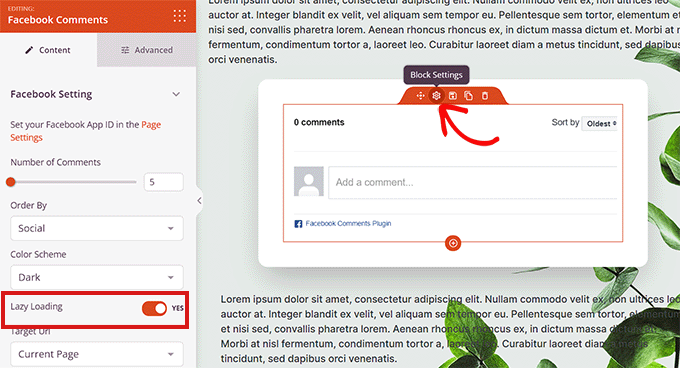
Als nächstes müssen Sie auf den Link „Seiteneinstellungen“ in der oberen linken Ecke des Bildschirms klicken.
Scrollen Sie dann nach unten zur Option „Facebook App ID“ und geben Sie Ihre Facebook App ID ein.
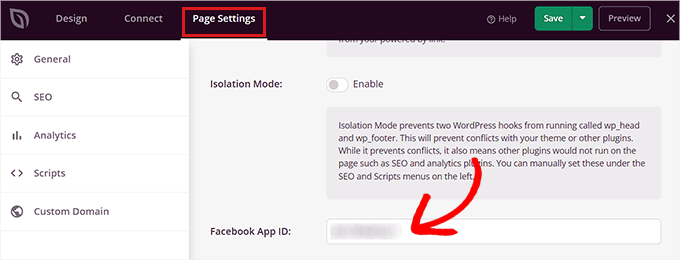
Wenn Sie fertig sind, klicken Sie einfach auf die Schaltfläche „Speichern“ am oberen Rand.
Die Facebook-Kommentare werden nun auf Ihrer WordPress-Website angezeigt.
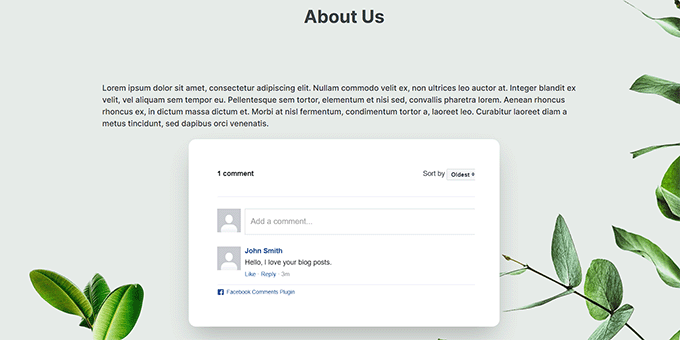
Bonus: Facebook-Like-Reaktionen zu WordPress-Beiträgen hinzufügen
Neben dem Hinzufügen von Facebook-Kommentaren können Sie auch Facebook-ähnliche Reaktionen zu den Beiträgen in Ihrem WordPress-Blog hinzufügen. Diese Reaktionen sind eine Reihe von Emojis, mit denen Besucher ihre Meinung zu einem Blogbeitrag ausdrücken können.
Das macht Ihren Blog interessanter und kann das Engagement steigern.
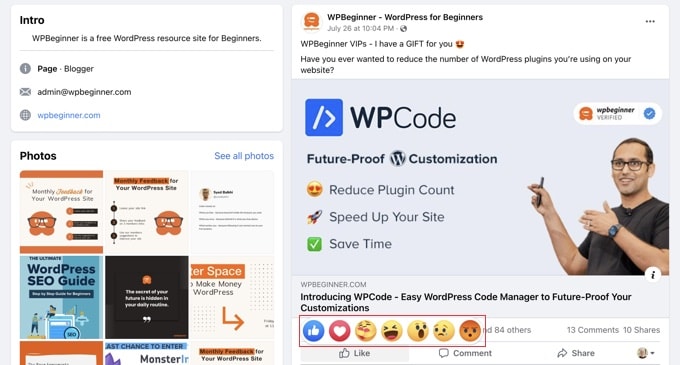
Um diese Reaktionen hinzuzufügen, müssen Sie das Plugin WP Reactions Lite installieren und aktivieren. Weitere Informationen finden Sie in unserem Leitfaden für Einsteiger zur Installation eines WordPress-Plugins.
Rufen Sie nach der Aktivierung die Seite WP Reactions “ Global Activation auf und klicken Sie auf die Schaltfläche „Jetzt anpassen“. Dies führt Sie zu einem neuen Bildschirm, auf dem Sie die Emojis auswählen können, die Sie als Reaktionen hinzufügen möchten.
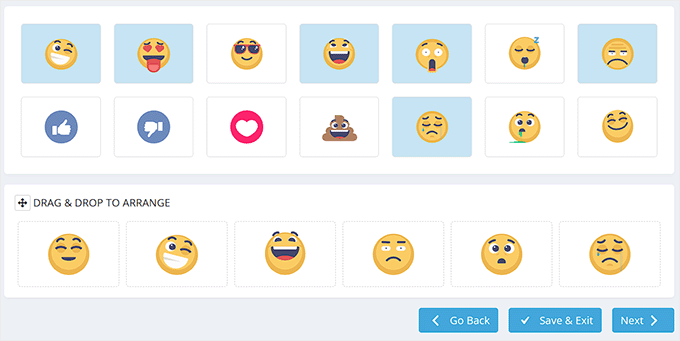
Klicken Sie dann auf die Schaltfläche „Weiter“, um fortzufahren. Hier können Sie die Reaktionsplatzierungen „Beiträge“ und „Nach dem Inhalt“ auswählen.
Sobald Sie dies getan haben, können die Nutzer Facebook-ähnliche Reaktionen hinzufügen und Facebook-Kommentare zu Ihren Artikeln posten, nachdem sie diese gelesen haben.
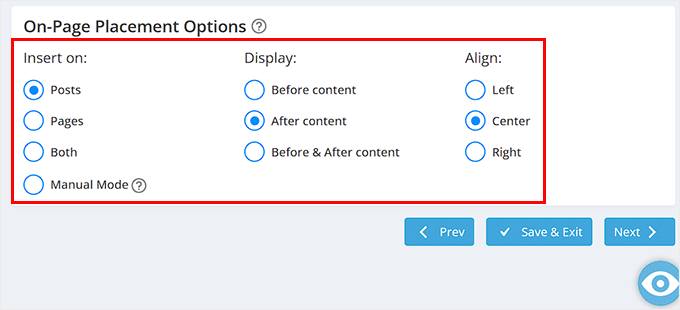
Sie können mit dem Plugin sogar ein CTA, eine Schriftfarbe und eine Rahmengestaltung hinzufügen. Wenn Sie fertig sind, vergessen Sie nicht, auf die Schaltfläche „Speichern und Beenden“ zu klicken, um Ihre Einstellungen zu speichern.
Sie haben nun erfolgreich Facebook-ähnliche Reaktionen hinzugefügt. Weitere Informationen finden Sie in unserer Anleitung zum Hinzufügen von Facebook-ähnlichen Reaktionen zu Ihren WordPress-Beiträgen.
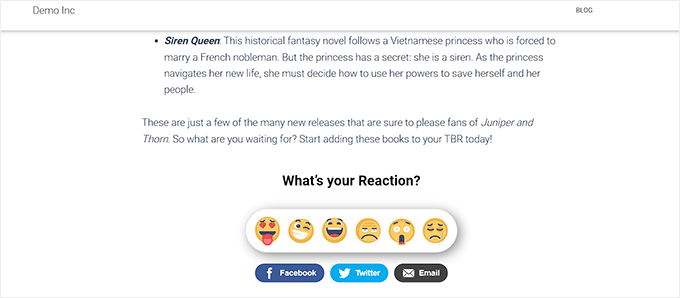
Wir hoffen, dass dieser Artikel Ihnen bei der Installation und Einrichtung von Facebook-Kommentaren auf Ihrer WordPress-Website geholfen hat. Vielleicht möchten Sie auch unseren Leitfaden zum Erstellen eines benutzerdefinierten Facebook-Feeds in WordPress und unsere Top-Picks für die besten SEO-Plugins für das Wachstum Ihrer Website lesen.
Wenn Ihnen dieser Artikel gefallen hat, dann abonnieren Sie bitte unseren YouTube-Kanal für WordPress-Videotutorials. Sie können uns auch auf Twitter und Facebook finden.





Syed Balkhi says
Hey WPBeginner readers,
Did you know you can win exciting prizes by commenting on WPBeginner?
Every month, our top blog commenters will win HUGE rewards, including premium WordPress plugin licenses and cash prizes.
You can get more details about the contest from here.
Start sharing your thoughts below to stand a chance to win!
Uchiha says
Im having trouble using this into my wordpress site. Please help me
Nilesh says
Hey, great article and very useful. Can you link the comments to a Facebook post or page?
Patrice says
The facebook comments plug in is working on my site however I still see the wordpress comments. How do I remove the wordpress comments?
David chriss says
Hi Patrice,
You Can Disable Default WordPress Comment By Using This Plugin Disable Comments
Details:- Requires: 4.0 or higher
Compatible up to: 4.6.1
Last Updated: 2 months ago
Active Installs: 900,000+
If you have another Question Feel Free To Reply To This Email
Or You Can Read This WP Beginner Article https://www.wpbeginner.com/plugins/how-to-turn-off-or-disable-comments-in-wordpress-pages/
I Hope I Help Some One Today
Best Regards,
David Chriss
Charne Cronje says
Hi David, Hope you are well, Has this plug in for facebook comments been updated for the new wordpress 4.7.2? And perhaps you might also know of a pinterest plugin that doesnt just show the pictures but also the description below, which works with the latest version of WordPress.
Thank you
Charne
xx
Sara says
Hi. I want to know if it’s possible to make the comments on my fanpage’s articles appear directly on my website’s articles and vice versa. Thanks!
Zaharadeen Elfakkawy says
Anytime someone tried to comment they get ‚message failed‘ error. Pls what’s the solution for thia
David chriss says
Hi,
Even me I Have That Common problem Please WP Beginner Help Us Or Any One can Help Us Please.
Please Help Us
Amit Jain says
Dear Team, What is the name of social share plugin you are using as i wish to install the same. It looks quite simple and sober. Regards, Amit Jain
sohib sanam says
thanks for share the update about facebok comment
Stelaras says
Do you know how i can change the position that the plugin is placed?
Ahmad Farisi says
Thx … but how to set notification to our facebook account if there is a new comment ?
Mahdi says
Hi Everyone, I was looking for a plugin who’s importing my facebook old comment from my facebook fanpage to my wordpress.
I tried this one but it’s not working, can anyone tell me how it works ?
I used another methode by commenting the embed comment and looks not really fine
Justin Enjo says
Hi WPBeginner – Quick question about Facebook Comments… How does it effect your SEO? Is it better to keep default WordPress comments or maybe Jetpack comments so that the comment content stays attached to your blog rather than fb? thanks.
WPBeginner Support says
Default WordPress comments are more SEO friendly in our opinion.
Admin
Pram says
I can’t find the plugin?
Aman says
This plugin is installed on my site and I have also activated coments mirroring for my page but still comment mirroring is not happening?
Do you know the way around to do this?
anish says
i have a site
Daniela says
Hello very well explained!! But I have a problem! The comments should show also on my fan page write? …..
……I did everything and I get my comments on my wordpress but not SHOWING on my facebook page why?? Help !!!!!! Thanks a lot. Daniela
Vikagutt says
I can’t get the plugin to work in Internet explorer. I can see from other threads on the net that others have the same experience. Some say that header.php should be modified, but I can’t figure out where in the file.
What to do?
Tabetha says
I set up this plugin with a test app. Right before I was due to launch the website, I had to switch over to the new app that was set up for the business the website was built for. When I changed the app ID to the new app, all of the comments kept going to the old app I set up for testing purposes. Even after I deleted the old app, deleted and reinstalled the plugin and verified that the correct app ID was being used in the api call.
Now, I have no way to moderate the comments because that old app is deleted and all the new comments are going to that old app even though the app ID I have in the plugin settings is for the new app ID.
Any ideas?
Steve says
..that facebook plugin is not updated since 11 months. Moreover, the plugin is made by some developer, and not Facebook. It does not feel very safe to use that plugin. Do you have any alternatives?
WPBeginner Support says
Sometimes plugin authors don’t feel the need to update a plugin because there is nothing changed or broken.
Admin
Rizwan says
Hi.. When i hyperlink another post from my wordpress blog to new post. All hyper links get shown below with ping back option. I don’t want them to show. Any advice?
mahendra says
great post !!! i have been searching for how to install facebook comments to my site. now i am going to use it on my site
thank you alot .
Paolo Euvrard says
ok, that’s all fine, I’ll switch to that from now on.
In order to disable the WordPress comments:
Settings >> Discussion >> uncheck „Allow people to post comments on new articles“
This applies to new posts that you will publish from now on.
To disallow comments from already publish posts:
Posts >> select them all and „Edit“ under bulk actions and hit apply >> choose „do not allow“ next to comments and hit update posts.
Autarka says
hey guys,
regarding to your plugin issues…
you need ipv6 addresses… without switching from ipv4 to ipv6 it isn´t working…
kindly, autarka
Mithilesh says
Not getting where to upload the plugin.
nacontact says
Hey, nice article, but I have some questions.
This blog here:
When you comment his facebook publication, it’s automatically commenting his blog, keeping the theme of the blog. When he comments his blog, it’s automatically commenting the facebook thread.
Any idea on how to do that?
Cheers,
Ramon says
Hello,
I would like exactly the same! Can’t find how to. Did you find the answer to this and would you want to enlighten me? What I’ve been Googling so far is things like:
„auto publish to facebook grab retrieve comments“
Thank you so much!
Greetings
Sara says
I have the same problem. Did you find a solution?
Cynthia Spencer says
I’m hoping it will help out with the user interaction on my site!
vimala says
But that just seemed to take me in a circle, and i never got what I needed.
Kenneth Adair says
There is NO Create App ID button here:
„Simply visit the Facebook Apps page and click on the create new app button. You will need to provide a name for your app and click on the Create App ID button.“
WPBeginner Support says
Follow the on screen instructions to create a new app.
Admin
Mark says
I just set it up and It’s pulling in 1200+ comments, but I’ve only just created my FB page and I have not comments on it yet. The stuff is from all over the place. How do I get it to just show my FB page’s comments
Rob says
I have exactly the same problem and will remove these coments now as it looks so fake. Anyone can see it is not genuine. What a disappointment! There are no instructions either about this, as far as I can see.
Esref says
Fake content is a big problem
Lisa says
Can I set up the comments to go with my Facebook page, or will it only work on my personal name feed?
Kanon Clifford says
How do you get rid of the default WordPress comments after the Facebook comments is installed? I have both showing up on my website…
Sarik Siddiqui says
How to remove the wp comments after this plugin has been installed
Sree says
I installed the plugin : i see the FB comments in edge but not always on chrome. some posts it appear some it does not.
second, even if i some one posts a comment on the webpost, it dont appear in FB and vice versa, the comment if posted on website, willbe visible there and not fb. and fb comments will be there , but not on website,
third i included the meta moderation tag with app id in header, but still icant see any moderation tool.
can u please help
Mike Bateman says
„Let’s have a personal and meaningful conversation.“ That’s cute. Anyway, I went to a blog that had FB comments installed, and when I scrolled down to comments, there was my FB profile staring out at me. Automatically. I had never been to that blog before – had never even heard of it.
I don’t want that. I don’t want it at any time, in any place, ever. So how do I stop it short of dumping facebook, which is starting to look like a good idea?
Michaele says
Mike,
If you don’t want to see your FB profile staring at you in the comments area of websites, you need to be logged out of FB while surfing the net.
Simple solution!
Alejandro says
Hi, the moderation tool doesn’t appear for me. I tried adding me as a moderator but it doesn’t work.
Can you help me please?
Juli Andrada says
Is there a way to recover lost fb comments after theme change?
Thank you ,
Juliana.
Stella Busolo Khachina says
Can it work with WordPress.com?
WPBeginner Support says
No.
Admin
Karolyn says
Hi! I dont know if its a facebook bug, but I installed the pluggin in my blog and it doesnt only shows the box for the comments for my posts but it also shows the bok with all the facebook developers page commets. Please help!!!
Stefan Badita says
It is not working on my blog i followed the steps, and on my section of comments and setting is not shown FACEBOOK
i followed the steps, and on my section of comments and setting is not shown FACEBOOK
Sanwal says
Thanks for the help. Its take max 5 minutes to do all these steps. Thanks a lot..
John Lee says
Any way to enable „Also post to Facebook“ by default? to it is checked?
Thanks,
John
Richard says
Same problem. I want it checked by default.
Flavia says
Hi, this was very helpful, but there’s one thing – I don’t get any notification about the comments, I didn’t receive a message on facebook or wordpress or email.
Do I have to change something in the settings? I didn’t find anything.
Thanks,
Flavia
WPBeginner Support says
Yes unfortunately Facebook comments are not synced with your WordPress.org comments.
Admin
Michaele says
Flavia,
I have the same problem. I have added myself as a moderator for comments under settings in developer tools. Yet I never receive any notifications for comments left on sites I moderate.
It seems that Facebook expects us to click on every single post on every site we moderate, every day to check if there is a comment to moderate. Hugely frustrating!
Clave Jones says
Same problem here. I don’t receive notifications anywhere of new comments. Surely I’m not expected to click around to every post, hoping to discover where new comments appear. Any guidance?
christina says
i followed all the directions and i can post via facebook on my blog, but it doesnt show my comment on facebook. Isn’t it supposed to post my comment to facebook as well or have i misunderstood something.
WPBeginner Support says
You will need to choose the option ‚Also post to Facebook‘.
Admin
Nancie says
Thanks very much for this tutorial
I just have one question. It appears that the plugin has not been updated for four years. Could I run into compatibility problems with my theme?
Thank you!
WPBeginner Support says
The plugin was updated last month
Admin
Pranish Shrestha says
I activated facebook comments, but my post show option for both wp default comment and fb comment box. how to completely deactivate wp defalut comment and show only fb commnt box.
Help plz.
Thanks
Kelly Scott says
Hey @Syed Balkhi,
Is it possible to install Facebook comments without plugin? I past comment code after related post but the same comments showing in all articles
You can check the result at
Can i do without plugins?
Thanks
polisiye says
Hi did you figure out this because I am having the exactly the same issue on my blog
Fiona says
Hi again,
Can comments be hidden? I’m concerned that, if a lot of comments are posted (I wish, and I don’t want to limit to 5), that the plethora will clutter the page!
Thanks again,
Fiona
Doug says
I notice that this article, like most, has a „share this article“ feature. Is this possible to add to my Word Press blog site so users can share it on social media?
WPBeginner Support says
You can use Floating Social Bar plugin for that.
Admin
Barbara Hernandez says
I hope you can help me.
I’m In the process of installing the Facebook comments plug-in to my wp website. It is asking me to put an APP ID how do I go about getting this – I tried going through – But that just seemed to take me in a circle, and i never got what I needed. Is there some other way to get this information for the setup phase.
WPBeginner Support says
Do you see a Create New App button when you visit Facebook Developers website?
Admin
Indigo says
I did this, but the comments only show from „post on Facebook“ to me, because my app is listed as „in development.“ It wants me to submit the app for review, even though I have no real app, just trying to use this plug in. How are people getting past this? So long as in development, no one but people in app roles can see anything posted to Facebook by the app. Thanks in advance for your help.
Joseph says
Hi… I guest the comment notifications doesn’t show up by default.
By the way, is this the recommend Facebook comment plugin? Any other alternative that you recommend?
I notice that WPBeginner doesn’t use Disqus any more. Just curious what comment plugin are you using now and why?
Regards,
Joseph
WPBeginner Support says
We are using default WordPress comments.
Admin
Patricia says
Just installed the plugin. Thanks for this tip!
Munir Kamal says
How to port facebook comment to new domain if a website is transferred to a new domain?
Is it possible?
Thanks,
Munir